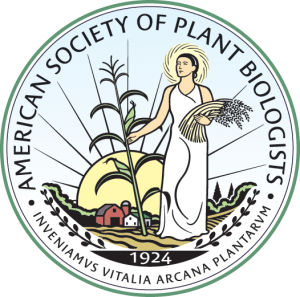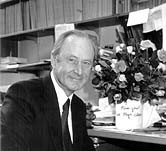Pioneer Member
DONORS
Amedeo Alpi
Dennis Brown
Kent Chapman
Joe Chappell
Maarten & Janet Chrispeels
Robert Donaldson
Sue Harley
Russell Jones
Masayoshi Maeshima
Irvin Mettler
Mikio Nishimura
Simon Robinson
Lincoln Taiz
Brady Vick
TESTIMONIALS
Joe Chappell – ASPP (before its renaming to ASPB) meant the world to Harry. He was the President of the Society in 1960 and the recipient of the Stephen Hales Award in 1970, recognizing his seminal research discoveries. As students, colleagues and co-workers with Harry, he delighted in having us attend the annual meetings and present our work. And he taught us how much fun it could be when invited to attend some of the special evening sing alongs. But the point for all of this was advocacy for good science, professional development and forging an enduring network of colleagues for life.
Robert P Donaldson – In the mid1970’s, Harry brought together a wonderfully diverse group of postdocs and grad students, including Ray Tully, Elma Gonzalez, Owen Young (Australian). Elma went on to a faculty position at UCLA. Harry brought me back to plant science following a sojourn into animal science in New York City. His UC Santa Cruz campus of red woods, banana slugs, bike trails and alfalfa sprout sandwiches was a welcome respite from the concrete canyons of New York.
Russell Jones – Harry was an excellent scientist and a great character!
Masayoshi Maeshima – I, Maeshima, spent a year as a postdoctoral researcher in the laboratory of Prof. Harry Beevers at UC Santa Cruz. The results were published in Plant Physiology, 79, 489-493 (1985). Professor Beevers discovered the glyoxisome as a new plant cell organelle and contributed to the development of plant science as ASPB President. He trained many researchers from all over the world, including me, thereby contributing to the training of future generations of plant scientists. I hope he will go down in history as an ASPB Pioneer.
Irvin J. Mettler – It was a distinct pleasure and honor to have a postdoctoral position in Harry’s lab from 1978-80 at UC Sana Cruz. Not only did I have the opportunity to work with a pioneer in the area of plant metabolism but also to work in a lab with a number of international visiting scientists. I was also provided the opportunity to have a part time appointment as a Lecturer in Biology for a Lab class in Plant Physiology. Work with Dr. Harry Beevers was very helpful in preparing me for my continued work in molecular biology and genetic engineering of tomato and corn plants.
Mikio Nishimura – When I went to Harry’s lab as a post doc, my research project was on studies of the distribution of gluconeogenetic enzymes, especially those in plastids. I had been working on the preparation of intact organelles from isolated protoplasts. Harry’s lab had developed methods for isolating intact organelles by chopping methods, However, the preparation of plastids was not suitable with the chopping method and needed other approaches. Harry was a Japanese Society of Plant Physiologists (JSPP) visiting professor and stayed several months in Akazawa’s lab and taught a great class on plant metabolism for Japanese students. At that time, Harry knew that I was developing a method for isolating organelles from protoplasts. He requested to apply it to his favorite material, castor bean. When I joined his lab, Hansjork Fritch, a German post doc, was in his lab working on citrate cleaving enzyme and later Irwin Mettler, an American post doc, and Francoise Tchang, a French post doc, and Joe Chappell, an American graduate student, joined the lab. I tried to prepare protoplasts from castor bean and succeeded in isoating them from germinating castor bean endosperm. Then, I prepared intact plastids from the protoplasts (Plant Physiol. 62: 40-43, 1978) and characterized subcellular localization of gluconeogenetic enzymes in this system (Plant Physiol. 64: 31-37,1979). This work identified isoenzymes of glycolytic enzymes and demonstrated that gluconeogenesis occurs in the cytosol, and the isoenzymes in plastids may play a role in synthesis of fatty acids in membranes, which is required for organelle development (Plant Physiol. 67: 1255-1258, 1981).
During the preparation of protoplasts, I recognized that transparent organelles of almost the same size as protoplasts contaminated the protoplast fraction. Harry and I understood that these organelles were vacuoles, because of staining with neutral red due to the acidic pH inside. I tried to isolate vacuoles by various sucrsoe gradients, but did not succeed. After centrifugation, the vacuoles were all gone. At first, we thought the vacuoles were fragile and were broken down during centrifugation. Finally, after a battle of 2-3 weeks, I found the vacuoles were not fragile, but sedimented at the bottom of the gradient. The vacuoles sedimented through even a 40% w/w sucrose layer, indicating their density is quite high. I remember how excited Harry was when we first saw the isolated vacuoles with a microscope, and me, too! As you might know, Matile proposed vacuoles are a lytic compartment, However, no direct evidence had been obtained from higher plants. Wagner & Siegelman were the first to isolate large amounts of vacuoles (Science 190: 129-1299, 1975), but they denied the lysosomal function of plant vacuoles (Plant Physiol. 59: 1098-1103, 1977). We were now in a good position to perform the project and determine whether or not vacuoles from castor bean have a lysosomal function. We found that most of the hydrolytic enzymes are present in vacuoles (Plant Physiol. 62: 4-48, 1978). The data from Buser et. al (Plant Physiol. 59: 1098-1103, 1977) possibly came from contamination of hydrolytic enzymes in their protoplast preparations. Our data were presented by Harry himself at the ASPP meeting at Blacksburg. I think this was the last presentation by Harry as an oral presentation. I realized that Harry was really pleased with the data we obtained. In order to demonstrate the lytic function of vacuoles, I discussed with Harry that conclusive evidence is necessary. We know that protein bodies in cotyledons are converted to vacuoles during germination. Therefore, the vacuoles must contain proteases and seed storage proteins are their substrate. We confirmed that vacuoles contain partially degraded storage proteins and finally succeeded in demostrating hydrolysis of proteins in isolated vacuoles (Nature 277: 412-413, 1979). I returned to Japan at January, 1979. Harry presented these data at the Presidental symposium at the Columbus, Ohio ASPP meeting in 1979, showing the vacuoles stained with neutral red; the image looked like the Japanese flag. Harry always emphasized the dynamics of organelles in plant cells , as shown by his interest in the transition of glyoxysomes to leaf peroxisomes. I believe this idea of Harry’s is based on the dynamic status of organelles in higher plants. After returning to Japan, I started studies on the peroxisomal transition and the dynamics of peroxisomes. We showed that highly oxidized peroxisomes are selectively degraded via autophagy (Plant Cell 25: 4967-4983, 2013), proposed as a two population model by Harry. Two degradation systems of LON protease 2 and autophagy are responsible for the peroxisomal transition (Plant Cell Physiol 55: 482-496, 2014). These studies are absolutely along the line of extending and developing Harry’s concept and philosophy. I learned a great deal from Harry and would like to express deep appreciation for giving me a chance to study in his laboratory and colaborate with him.
Simon Robinson – Apart from being a truly pioneering plant physiologist, Harry was a great mentor to younger scientists and a wonderful person to work with. He encouraged and supported everyone in his lab and loved having in depth discussions about science, politics, life and just about anything else. Harry really was the epitome of a scholar and a gentleman.
Lincoln Taiz – Harry Beevers was a valued and admired colleague in the MCD Biology Department at U.C. Santa Cruz. His seminars and classroom lectures were always notable for their brilliance, clarity, and razor sharp wit. As a junior faculty member, I benefitted greatly from his views and opinions, which helped me to navigate the always fraught landscape of campus politics. I’m also grateful for the warm hospitality that Harry and Jean frequently provided Lee and me at their beautiful home, which helped us to expand our social circle. I also have fond memories of our weekly walks over to Crown College’s small Deli, “Banana Joe’s,” for lunch. Harry had a few pet peeves. Perhaps the most egregious of these was the use of teleology in science, which always provoked a withering response. As a result, his students quickly learned the difference between teleology and evolutionary adaptation, or suffered the scorn of the master.
Brady Vick – When I arrived at UC Santa Cruz in the spring of 1975, Harry and his wife Jean invited my wife, infant daughter, and me to stay in their home in Pasatiempo for a couple nights until we found an apartment. So nice! In the lab, Harry assigned me to a project to identify the subcellular location (in castor bean, of course) of a key enzyme in the initial step in the biosynthesis of phospholipids, and then let me attack it. A month or two later he took off for Europe and Australia on a sabbatical, and didn’t come back until the following spring. I guess he trusted me enough to get the job done without his presence, which I did, with some help from others in the lab (postdocs Rob Donaldson and Owen Young, and Ph.D. student Ray Tully). When Harry came back after nearly a year’s absence, he assigned me another project to determine the subcellular location of fatty acid synthesis in germinating castor bean. So, we got two nice papers in Plant Physiology during my two years working in Harry’s lab. A great experience! My wife and I also enjoyed frequent visits to the Beevers’ home for dinners whenever notable plant physiologist colleagues from around the country and world would come to visit Harry (I specifically remember a dinner with retired Dr. Kenneth Thimann and his lovely, animated wife!). While Jean prepared the meal, it was always Harry who prepared the dessert…Bananas Foster, bananas in a banana liqueur and rum sauce over vanilla ice cream, with fire!

